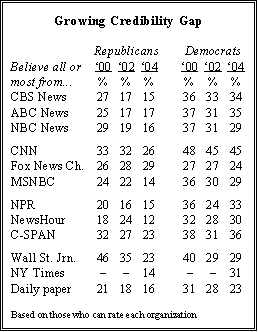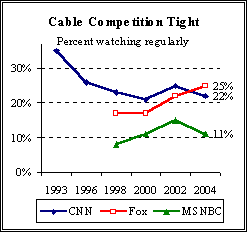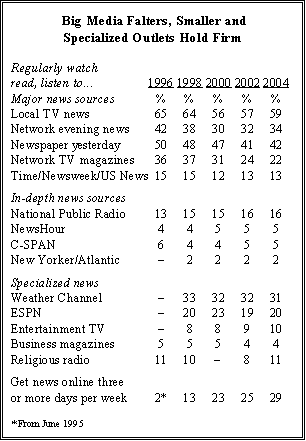Overview
 Despite tumultuous events abroad, the public’s news habits have been relatively stable over the past two years. Yet modest growth has continued in two important areas online news and cable news. Regarding the latter, the expanding audience for the Fox News Channel stands out. Since 2000, the number of Americans who regularly watch Fox News has increased by nearly half from 17% to 25% while audiences for other cable outlets have been flat at best.
Despite tumultuous events abroad, the public’s news habits have been relatively stable over the past two years. Yet modest growth has continued in two important areas online news and cable news. Regarding the latter, the expanding audience for the Fox News Channel stands out. Since 2000, the number of Americans who regularly watch Fox News has increased by nearly half from 17% to 25% while audiences for other cable outlets have been flat at best.
Fox’s vitality comes as a consequence of another significant change in the media landscape. Political polarization is increasingly reflected in the public’s news viewing habits. Since 2000, the Fox News Channel’s gains have been greatest among political conservatives and Republicans. More than half of regular Fox viewers describe themselves as politically conservative (52%), up from 40% four years ago. At the same time, CNN, Fox’s principal rival, has a more Democrat-leaning audience than in the past.
The public’s evaluations of media credibility also are more divided along ideological and partisan lines. Republicans have become more distrustful of virtually all major media outlets over the past four years,  while Democratic evaluations of the news media have been mostly unchanged. As a result, only about half as many Republicans as Democrats rate a variety of well-known news outlets as credible a list that includes ABC News, CBS News, NBC News, NPR, PBS’s NewsHour with Jim Lehrer, the New York Times, Newsweek, Time and U.S. News and World Report.
while Democratic evaluations of the news media have been mostly unchanged. As a result, only about half as many Republicans as Democrats rate a variety of well-known news outlets as credible a list that includes ABC News, CBS News, NBC News, NPR, PBS’s NewsHour with Jim Lehrer, the New York Times, Newsweek, Time and U.S. News and World Report.
CNN’s once dominant credibility ratings have slumped in recent years, mostly among Republicans and independents. By comparison, the Fox News Channel’s believability ratings have remained steady both overall and within partisan groups. Nonetheless, among those able to rate the networks, more continue to say they can believe all or most of what they hear on CNN than say that about Fox News Channel (32% vs. 25%).
 The partisan nature of these ratings is underscored by the fact that, while roughly the same proportion of Republicans and Democrats view Fox News as credible, Fox ranks as the most trusted news source among Republicans but is among the least trusted by Democrats.
The partisan nature of these ratings is underscored by the fact that, while roughly the same proportion of Republicans and Democrats view Fox News as credible, Fox ranks as the most trusted news source among Republicans but is among the least trusted by Democrats.
The biennial news consumption survey by the Pew Research Center for the People and the Press finds that ideology and partisanship also are at work in other media choices and attitudes. The nationwide poll of 3,000 adults, conducted April 19-May 12, 2004, finds that the audiences for Rush Limbaugh’s radio show and Bill O’Reilly’s TV program remain overwhelmingly conservative and Republican. By contrast, audiences for some other news sources notably NPR, the NewsHour, and magazines like the New Yorker, the Atlantic and Harper’s tilt liberal and Democratic, but not nearly to the same degree.
 The signs of greater polarization in news choices come against a backdrop of overall stability in the public’s preferences. Local TV news continues to be the most popular medium, but regular viewership is still below levels recorded in the mid-1990s. Similarly, reported levels of regular newspaper reading and viewing of network evening news broadcasts have not recovered from their decade-long slump, though they have not declined further.
The signs of greater polarization in news choices come against a backdrop of overall stability in the public’s preferences. Local TV news continues to be the most popular medium, but regular viewership is still below levels recorded in the mid-1990s. Similarly, reported levels of regular newspaper reading and viewing of network evening news broadcasts have not recovered from their decade-long slump, though they have not declined further.
The traditional news outlets have failed to expand their audiences despite the high level of interest in the war in Iraq, which has led to an uptick in the amount of time Americans spend on the news. Moreover, there has been a sharp rise in the percentage of Americans who say they closely follow international news most of the time, rather than just when important developments occur. The number tracking overseas news closely most of the time has increased from 37% in 2002 to 52%, which appears to be driven by the broad interest in the conflict in Iraq.
 With most other media trends flat, the steady growth in the audience for online news stands out. Internet news, once largely the province of young, white males, now attracts a growing number of minorities. The percentage of African Americans who regularly go online for news has grown by about half over the past four years (16% to 25%). More generally, the Internet population has broadened to include more older Americans. Nearly two-thirds of Americans in their 50s and early 60s (64%) say they go online, up from 45% in 2000.
With most other media trends flat, the steady growth in the audience for online news stands out. Internet news, once largely the province of young, white males, now attracts a growing number of minorities. The percentage of African Americans who regularly go online for news has grown by about half over the past four years (16% to 25%). More generally, the Internet population has broadened to include more older Americans. Nearly two-thirds of Americans in their 50s and early 60s (64%) say they go online, up from 45% in 2000.
The survey finds that many Americans especially older people look for in-depth news coverage. Moreover, a majority of college graduates (55%) say they better understand the news when they read or hear it rather than seeing pictures or video. The durability of the serious news consumer is reflected in the steady numbers of Americans who are regular consumers of news from NPR, the NewsHour, C-SPAN, and magazines such as the New Yorker, the Atlantic and Harper’s.
 For the most part, these audiences have not increased in size in recent years, but they have not suffered the long-term declines experienced by newspapers and network evening news. In addition, more specialized news outlets ranging from the Weather Channel to religious radio also have held their own in the changing news environment.
For the most part, these audiences have not increased in size in recent years, but they have not suffered the long-term declines experienced by newspapers and network evening news. In addition, more specialized news outlets ranging from the Weather Channel to religious radio also have held their own in the changing news environment.
Other findings:
- Beyond politics, news habits are being subtly shaped by some basic preferences and attitudes toward the news. About half (52%) like to get the news at regular times while nearly as many (46%) are “news grazers,” who check in on the news from time to time. Grazers are younger, less dedicated to the news, and have an eclectic news diet.
- The age gap in newspaper readership continues to widen. Six-in-ten Americans age 65 and older say they read a newspaper on a typical day, compared with just 23% of those under age 30.
- Roughly three-quarters of Americans (76%) say they have a digital video disc (DVD) player, more than quadruple the percentage in the 2000 media survey (16%). But video cassette recorders have not faded into oblivion 92% of the public has a VCR.
- The public continues to express skepticism toward news outlets and those who run them. More than half (53%) agree with the statement “I often don’t trust what news organizations are saying.” Nearly as many (48%) believe people who decide on news content are “out of touch.”
- Regular readers of literary magazines like the New Yorker and the Atlantic proved to be the most knowledgeable 59% correctly answered four current events questions, a higher percentage than any other news audience. The readership of these magazines also has the greatest proportion of college graduates. Readers of political magazines such as the Weekly Standard and The New Republic rank second, along with the audience for Larry King Live. King’s audience is not as well-educated as the readership of literary or political magazines, but is considerably older.


